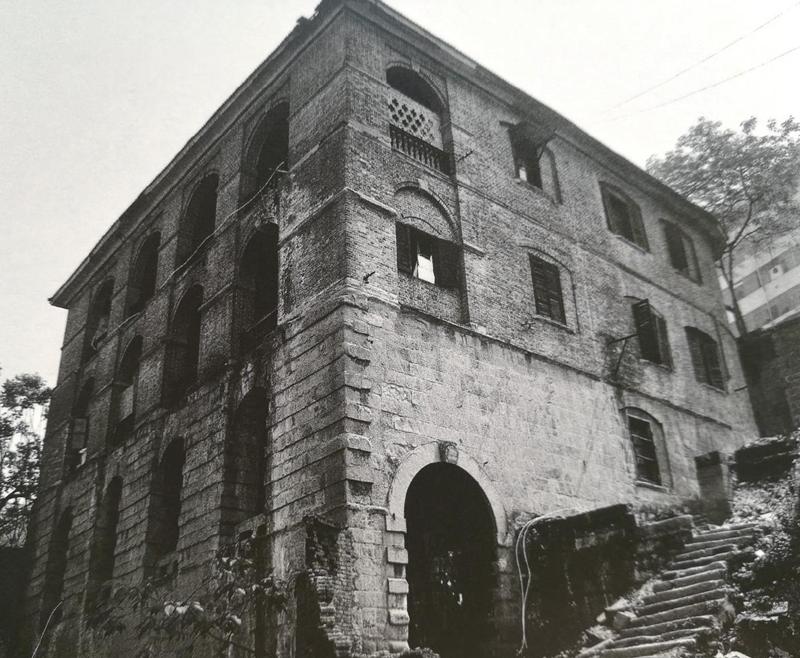卜内门洋行 见证中国“洋皂”百年
2021-08-09杨艳龙晓
杨艳 龙晓

位于南岸區南滨路、依山而建的卜内门洋行旧址,也是曾经的卜内门贸易公司办事处、卜内门洋碱公司。20世纪初,老百姓习惯把生活日用品肥皂、碱、火柴、钉子,称作洋皂、洋碱、洋火、洋钉。当时,这些都是漂洋过海从西方进口的时髦用品。
1873年,英国人卜内与门氏合作,由经营洋碱起家,创建卜内门公司(Brunner Mond&Co),总部设在伦敦。这家公司是当时英国四大公司之一,也是今天财富世界500强企业之一、全球化工行业前十的英国帝国化学工业集团(ICI)的前身。
1891年重庆开埠,外国企业、银行等机构纷纷进入重庆。1898年,英国卜内门公司在上海设立驻中国总公司。1904年,在重庆开设机构,推销“洋碱粉”、开办肥皂厂,取名“祥合公司”。聘请南京技术工人进行生产,月产肥皂4000箱。
当年,卜内门公司是最早进入中国、规模最大的外国洋碱生产销售企业,是重庆最著名的洋行之一。卜内门洋行在重庆开办后,刺激和推动了重庆肥皂业的发展,到20世纪30年代中期,重庆开办了5家肥皂厂。抗战爆发后,随着内迁工厂的增加,至1942年,重庆制皂工厂发展到23家。可以说,卜内门洋行见证了中国百年“洋皂”发展历史,是研究重庆开埠历史以及社会、经济发展最好的实物资料佐证,具有重要的历史研究价值。
卜内门洋行旧址整体建筑为青砖墙体,小青瓦屋面,圆弧形石砌拱门。如今,依稀还能看到昔日洋行的气派风格。楼高三层,临江面有外廊,举目远眺,是开阔的江面,对面就是渝中半岛。底层采用横向条石砌筑,正大门朝南,门楣上依稀可见刻有“1915”字样,其他文字风化严重。建筑主体虽保存完好,但内部皆有不同程度的损毁。斑驳的石栏杆上的石雕、破损的门窗木地板、残缺的壁炉,昭示着它曾经的辉煌。
岁月流逝,历史留痕。在抗战时期,国民政府有关单位在卜内门洋行仓库开办过训练班,也作过临时学校和避难场所。新中国成立后,这里也曾作为重庆三链厂的职工宿舍。
如今,在重庆两江国际影视城临江路5号,有一栋没有任何店招的三层小洋楼,青条石砌成一楼,楼上是青砖,外廊上为木质栏杆,细节处处体现着这栋建筑不凡的历史。它的原型就是卜内门洋行旧址,于2016年10月仿建完成。
一个世纪过去了,今天的卜内门洋行旧址,作为重庆开埠历史的见证,被列为重庆市文物保护单位。据南岸区文化与旅游委相关负责人介绍,作为城市记忆的载体,卜内门洋行旧址将通过修缮和保护,重新焕发活力。
Located in Nanbin Road, Nan'an District and built on the mountain, the former site of the Brunner Mond & Co is also where the working office of this previous foreign trading firm was placed. In early 20th century, Chinese people used to name daily necessities like soap, matches and nails foreign soap, foreign matches and foreign nails, all of which were fashionable goods imported from the West.
In 1873, British national Brunner found the Brunner Mond & Co with Mond in London engaged in alkali business, becoming one of the four largest companies in the UK at that time, and it is the predecessor of ICI, one of the Fortune 500 companies in the world and one of the top 10 companies in the global chemical industry.
Chongqing was opened as a port in 1891, which attracted foreign enterprises, banks and other institutions to arrive one after another. In 1898, the British firm Brunner Mond & Co established its China headquarters in Shanghai and a branch in Chongqing in 1904, which set up a soap factory named "Xianghe Company" to promote "foreign soap powder" , with skilled workers employed from the east Chinas Nanjing city who could produce 4,000 boxes of soap per month.
At that time, Brunner Mond & Co was the first and largest foreign enterprise to produce and sell foreign soap in China, and one of the most famous foreign companies in Chongqing. The presence of the company in Chongqing stimulated and promoted the development of Chongqing's soap industry. By the mid-1930s, Chongqing had opened five soap factories. Since the outbreak of the Anti-Japanese War in 1937, with the increase of factories moved in from elsewhere of China, there had been 23 soap factories in Chongqing by 1942. It can be said that having witnessed the development of "foreign soap" in China over one hundred years and serving as the best physical evidence for the study of Chongqing's port opening history and social and economic development, Brunner Mond & Co has high value of historical research.
The whole building of the relic of the company is a green brick wall, a small green tile roof and an arc-shaped stone arch, by which we can still trace the style of the former foreign firms. Standing at three stories high, the building is provided with a veranda overlooking the river, from which one can see the wide open river and the Yuzhong Peninsula on the opposite side. The ground floor is built with horizontal stones, with the main gate facing southward and the figure "1915" faintly visible on the lintel but other words unrecognizable due to heavy weathering. Although the main body of the building is well preserved, the interior is in varying damage. The stone carvings on the mottled stone railings, the broken wooden floors of doors and windows, and the incomplete fireplace all imply the past glory of the structure.
As time goes by, history leaves its mark. During the Anti-Japanese War in 1937 to 1945, agencies of the relocated Chinese national government set up training classes, temporary school and shelters in the warehouse of this foreign firm. After the founding of the People's Republic of China in 1949, the site was also used as the dormitory of Chongqing No.3 Chain Factory.
Today, at 5 Linjiang Road, Liangjiang International Film and Television City, Chongqing, there is a three-story small building of western style but without any shop signs. The first floor is made of green stones. The upper floor is made of green bricks, and the outer corridor is covered with wooden railings. The details inside and out reflect the extraordinary history of the building. It is a building made after the relic of Brunner Mond & Co, completed in October 2016.
A century later, the site of Brunner Mond & Co, as a witness of Chongqing's port opening culture, is listed as a cultural relic under protection in Chongqing. According to the official of the Culture and Tourism Commission of Nan'an District, as the carrier of city history, the former site of Brunner Mond & Co will be rejuvenated through repair and protection.
